An unassuming and tiny forest stream snakes through the urban townscape of Northern Singapore. Surrounded by fruit trees and overgrown grass, the place is unlike many built-up spaces in the urbanised city-state.
To continue reading, subscribe to Eco‑Business.
There's something for everyone. We offer a range of subscription plans.
- Access our stories and receive our Insights Weekly newsletter with the free EB Member plan.
- Unlock unlimited access to our content and archive with EB Circle.
- Publish your content with EB Premium.
For young explorers wading waist-deep in the cool waters while they participate in stream surveys there, as long as they look carefully, they find what they seek: plenty of interesting nature and the space teeming with biodiversity.
For 27-year-old Neo Xiaoyun, who facilitates walks along the freshwater stream and affectionately refers to it as the “Chencharu Stream” after the name of the lane it sits near to, the place holds deep meaning for evoking yearnings that she has had since childhood – her aspiration to teach in the outdoors, to help young children connect with each other, and to be in nature.
The stream also runs behind a community-initiated space, managed by Ground-Up Initiative (GUI), where Neo has been volunteering for three years, now as an environmental educator. It is where she says she can just “chill and hang out” after a long day, and where she found her chosen community.
Even if it is land that is about to be lost, it can still be a good starting point, a place for people to spark that connection with nature.
GUI, unfortunately, has to vacate the 2.6-hectare site it has been operating on by mid-year, to make way for future developments and as its lease expires. In February this year, it announced that it will move to a nearby site, which is smaller than the original one. Neo says the non-profit will need to raise more than S$4 million (US$3 million) in eight phases, to fund the construction cost of the new space.
“In Singapore, there is very little land that is truly untouched,” said Neo. “Yet, as a space, GUI still feels drastically different from the rest of Singapore. It is a good platform for many people to reconnect with the land and to touch nature.”
“When I show people pictures of GUI, they are shocked. They ask: are you sure this is Singapore? I think the space stands for a proposal of a set of values alternative to the general and dominant set of values that Singapore often is for,” she said.
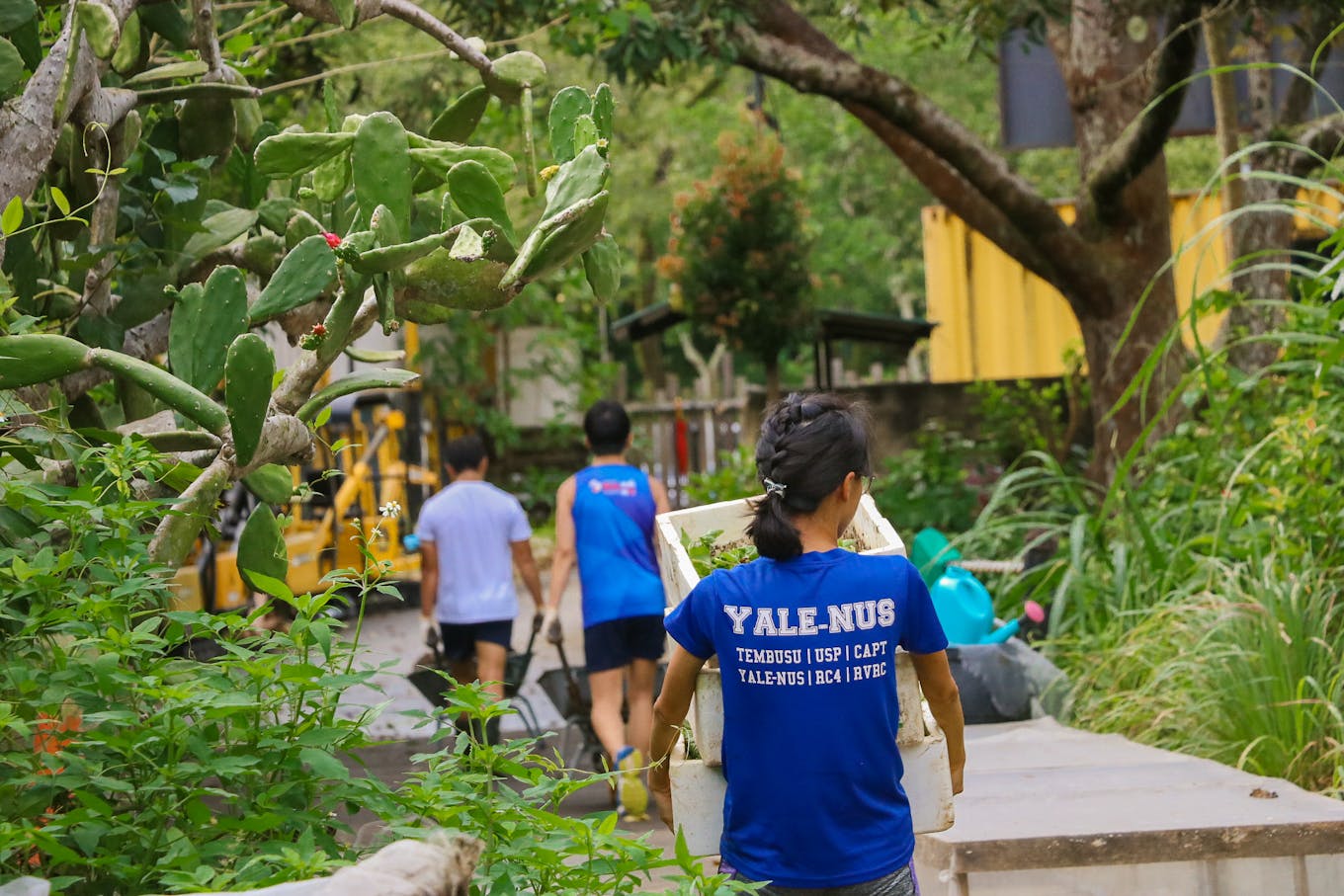
Volunteers moving earth at the community-run space managed by Ground-Up Initiative. Image: Neo Xiaoyun
It is also why the volunteers at GUI continue to work on the old plot of land at Lorong Chencharu, as it sits on borrowed time. Last year, The Untamed Paths, the organisation which Neo works with to facilitate outdoor education programmes, decided to enter GUI’s “backyard”, and organise naturalist camps for children aged between 6 and 12 years-old, as well as stream walks along the Chencharu Stream, under a new initiaitive known as Cyan. For Neo, the decision was a “leap of faith”, but also a worthy venture. It marries the work that she has been involved in for both organisations.
The Untamed Paths will have the space until end 2023, but have to later shift from GUI’s backyard to “front yard”, said Neo.
Neo, one of the Eco-Business Youth A-List 2022 winners recognised for her work in environmental education, tells Eco-Business why it is alright to start small and what she thinks makes a good environmentalist.
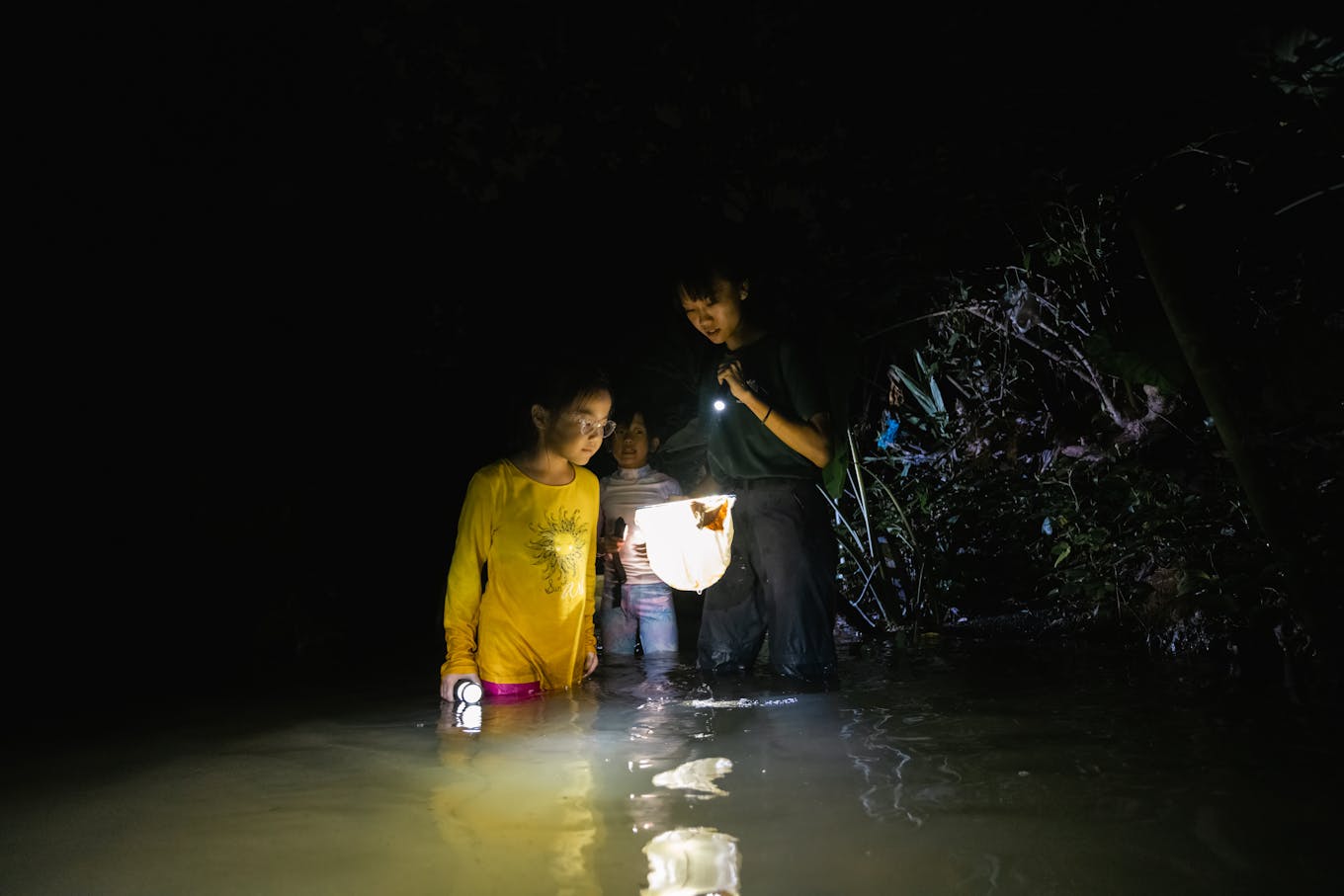
Neo (right) guiding a night stream survey in Singapore for young children. Image: Neo Xiaoyun
What has the past year been like for you? Do you think there is a central theme to all that you do?
Last year was quite a fulfilling year. I started it with very little hope. We had gone through the whole pandemic, and I was waiting for things to start, but felt that things were not moving fast enough, both at my workplace, and for my personal endeavours. But then things picked up. In my day job [as an officer working at the Civil Aviation Authority of Singapore], I had a chance to represent Singapore at conferences, understand policy-making and how we present ourselves on the international stage. It gave me good insight into how climate diplomacy can be conducted internationally too. The Untamed Paths also took off. Every two or three days, I was facilitating a programme and there was demand. Through the four to five core programmes I helped to facilitate, I engaged more than 600 participants.
Another highlight was all the trips that I went on. Last April, I went to Tulamben in Bali. I did my first dive outside Singapore. Recently, we are starting a new project on coral restoration there. So one theme that runs strongly throughout the past year was the reignition of connections. We could meet up with our partners. It was also personally fulfilling because I realised there is so much wildlife outside of Singapore.
However, for Ground-Up Initiative, there was a lot of waiting. We thought we had to move [out of the space] before December 2022. It took a long time to finalise the details, and it was just very difficult.
With land in Singapore, it is kind of like a ticking clock, right? You have a piece of land that you are attached to, but there seems to be expiry dates or deadlines attached to any plot you seem to own. How does that affect the relationship you have with spaces that you are familiar with?
I think this is a question that a lot of our volunteers deal with. We have people asking: if the land is going to be taken back, why are you still working on it? Unfortunately, GUI has lived in limbo for such a long time. GUI’s model is that we are generally cooperative with the government, and that means taking a long time to get replies from relevant agencies on how long the extension [for the land lease] is. Negotiations take a long time. It is just a reflection of the operating environment for GUI.
“
I have never been one to sit and mull over things, or be thrown into a depressive state, so I think I am lucky. I don’t think we can just say, “I am just another human being here to get resources from the earth.” We need to know we are connected to the land somehow and it’s not just a place where we pass through in life.
I do think that in Singapore there is very little land that is truly untouched. Yet, as a space, GUI still feels drastically different from the rest of Singapore. It is a good platform for many people to reconnect with the land and to touch nature.
Even if it is land that is about to be lost, it can still be a good starting point, a place for people to spark that connection with nature.
Can you tell us more about the new Cyan programme?
Cyan is still very young. I was very surprised when The Untamed Paths wanted to go into GUI’s backyard [to run this outdoor classroom programme], since the plot was there on borrowed time. But we took a leap of faith and fostered this partnership between the two organisations that I was part of. It took about two to three months to build up a minimalist and simply furnished space and we have only had eight months of running programmes. We have had 10 camps for kids aged between 6 to 12 years old.
It is quite challenging facilitating the social-emotional learning of these children. They are at this phase when everything we tell them is very important. Nature is but a platform for so many important lessons. So we run the programme with the hope of wanting to help nurture “the full child”. The principles behind Cyan are hence also a mix of that of The Untamed Paths and GUI. The initiative is about outdoor learning, and also about building the resilient child that can connect with other children.
We organise stream surveys, open up the Chencharu Stream, a part of nature that has not been tapped on at night. For The Untamed Paths, our first love is snakes, but previously when we were looking for snakes, we inevitably found invertebrates and discovered there is a whole ecosystem out there. So we are bringing that knowledge to the stream walks. The children will have to navigate knee-high or even waist-high water. They will have to learn to quieten down. And I am realising that it is such a rare opportunity for an important connection with nature. Children hardly ever enter freshwater streams now. There would be children who start off initially being very scared and anxious, but by the middle of the walk, they’ll be swimming and relaxed. They then come back for their second stream walk.
I also didn’t realise how meaningful it personally was for me. It reminded me of how when I was younger. I’d always wanted to be an outdoor education facilitator, and all these hidden dreams that I had as a child were surfacing. I realised that I’d always been unlocking the passion I had in me since childhood.
The Chencharu Stream is so small and unassuming, but there is a lot of wildlife. It is such a shame that it will be lost to development, although we will have the stream until December this year, which is great. The current space that Cyan operates on will have to move from the backyard to the front yard, and we will continue to offer our programmes there.
When I think about time, I always think about how the year is short, but days are long. So there are still plenty of opportunities.
You have travelled to many places – Hawaii, Bali and Sumatra. Tell us more about some of your trips. How did they help you grow?
I travelled to Hawaii to be part of the Young Southeast Asian Leaders Initiative (YSEALI) academic fellowship programme. In Indonesia, The Untamed Paths was working with [local rescue groups] Sumatra Eco Project and Bali Reptile Rescue, as we looked at expanding the organisation’s footprint regionally. [Our founder] Dennis, was supporting different overseas groups financially through his personal means during the Covid-19 pandemic, and so now we have partners elsewhere.
For example, there is a lot of interest in exploring how we can work with Bali Reptile Rescue to combat illegal wildlife trafficking and to work on animal rescues. The Bali that most Singaporeans know is just the hotels and resorts on the island, and tourism, but the flipside of such tourism is that Bali faces the problem of having a high rate of local extinctions – at a rate almost similar to Singapore’s. The group tries to rescue the large snakes before they get killed by property owners, retrieving them and dropping them off in the nearest forested areas. It tries to promote an understanding of the natural ecosystem to the Balinese and the tourists. If the large snakes are culled, they can’t eat the smaller snakes, and the smaller snakes in turn can’t eat the rats. You cannot just rescue the small ones and kill the king cobras. We are all connected with one another.
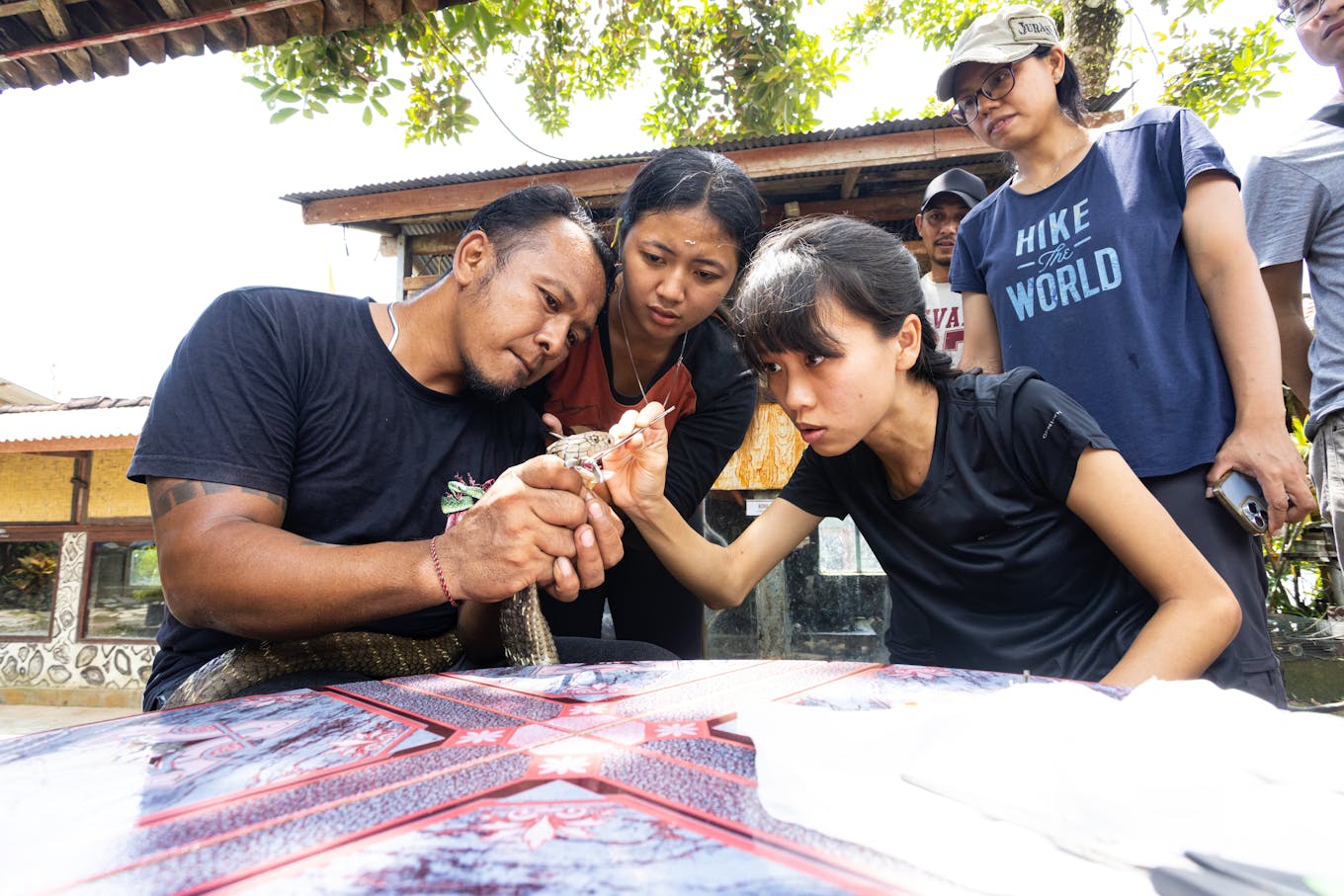
The Untamed Paths was in Bali in January this year to work with a reptile rescue group. Neo (right) is pictured trying to remove parasitic worms from a king cobra. Image: Neo Xiaoyun
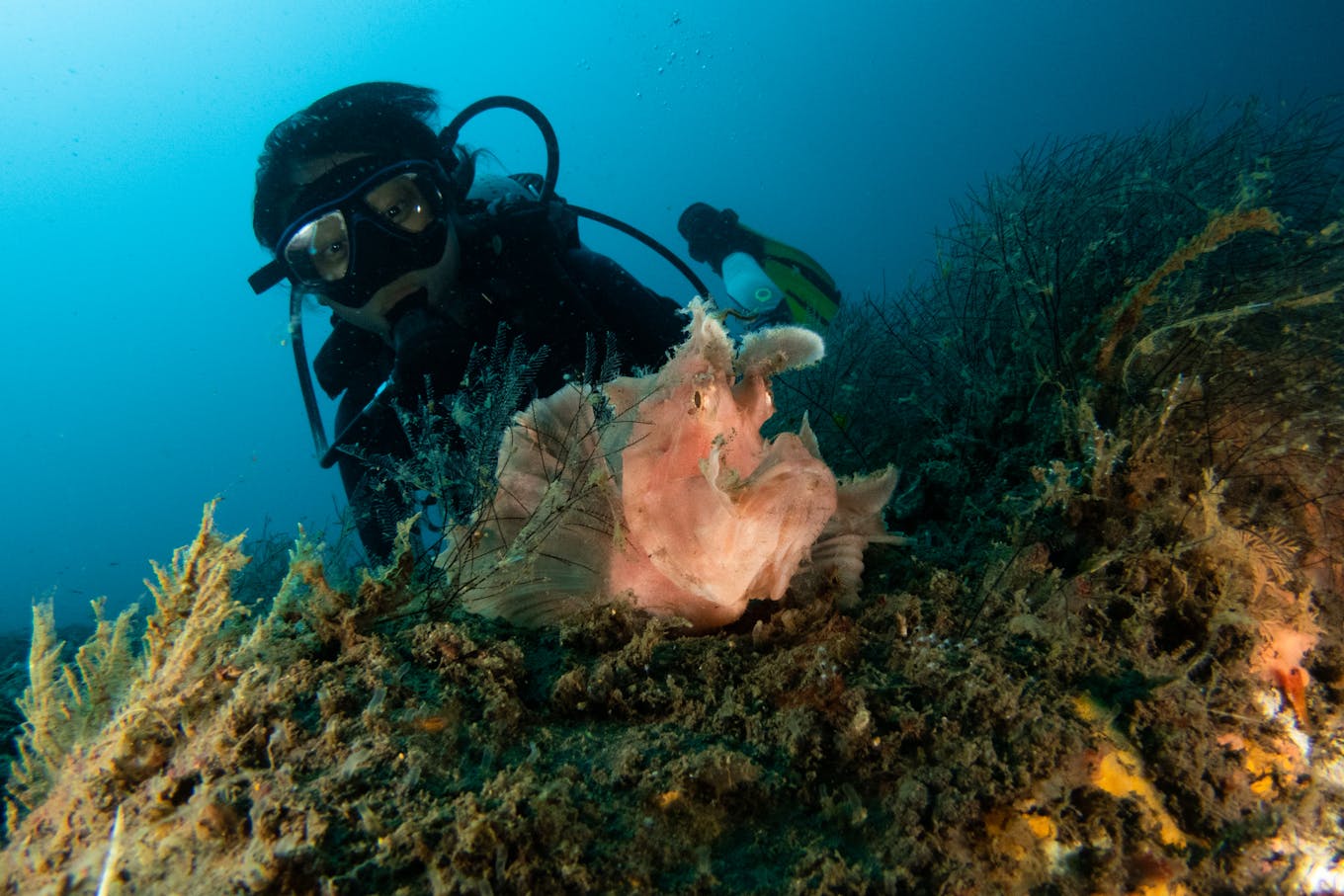
Neo meeting a scorpion fish on her dive in Tulamben, Bali. It was her first dive outside of Singapore. Image: Neo Xiaoyun
The trips also made me realise that what Singapore has to offer is financial muscle. The region needs this. It is another way we can create the change that we want. The resources we have are going to be so much more amplified if we can take them abroad. For example, on our trip to Bukit Lawang, Sumatra, which is at the fringe of the Gunung Leuser National Park, one of the largest national parks in Indonesia, we realised that there is a need for a lot of funding, to provide for medical supplies for the animals which need constant care and rehabilitation before they are released.
Once, they rescued a crested serpent eagle which is a very majestic creature, but its wings were clipped and it was in a lot of pain. After three weeks, they decided they had to kill it because it was not doing well and not eating anything. Stories like that are tragic. We started connecting them with vets, and in the future, we can maybe work on a placement programme for Singapore vets to work in Bukit Lawang.
I think having regional partners in mind while we go about our work makes us better environmentalists. In Singapore, many people, including myself, seem to think that someone else can always do the job or meet a certain need. But there is so much to do, and we should take action.
As an environmental advocate, do you think your view of the natural world is affected or shaped by the fact that you are essentially an urbanite living in Singapore? How does that affect your relationship with nature?
I do think a lot about values and how values seen as important in Singapore are being reflected in our urban landscape. Working on my research article [published in 2021] on anti-environmental values found in Singapore’s history textbooks, I found that the non-human environment is mostly being represented from a utilitarian perspective, for example as something to be used. The values are then further reinforced by the fact that we live in spaces like these.
It is also how we project our brand image to the rest of the world. When I show people pictures of GUI, they are shocked. They ask: are you sure this is Singapore? I think the space stands for a proposal of a set of values alternative to the general and dominant set of values that Singapore often is for. Spaces like GUI or agricultural lands are, in fact, less than 5 per cent of the whole of Singapore. Very small and very marginal. But we do have to start somewhere. If we don’t even have these alternatives, there is no way to imagine something else.
And it is inspiring to do this because there are lots of other social groups and enterprises also creating their alternative views of Singapore through the work they do. Collectively we reach out to a wider group of Singaporeans and we also get out of our own echo chambers.

Neo guiding an intertidal walk for preschoolers. Image: Neo Xiaoyun
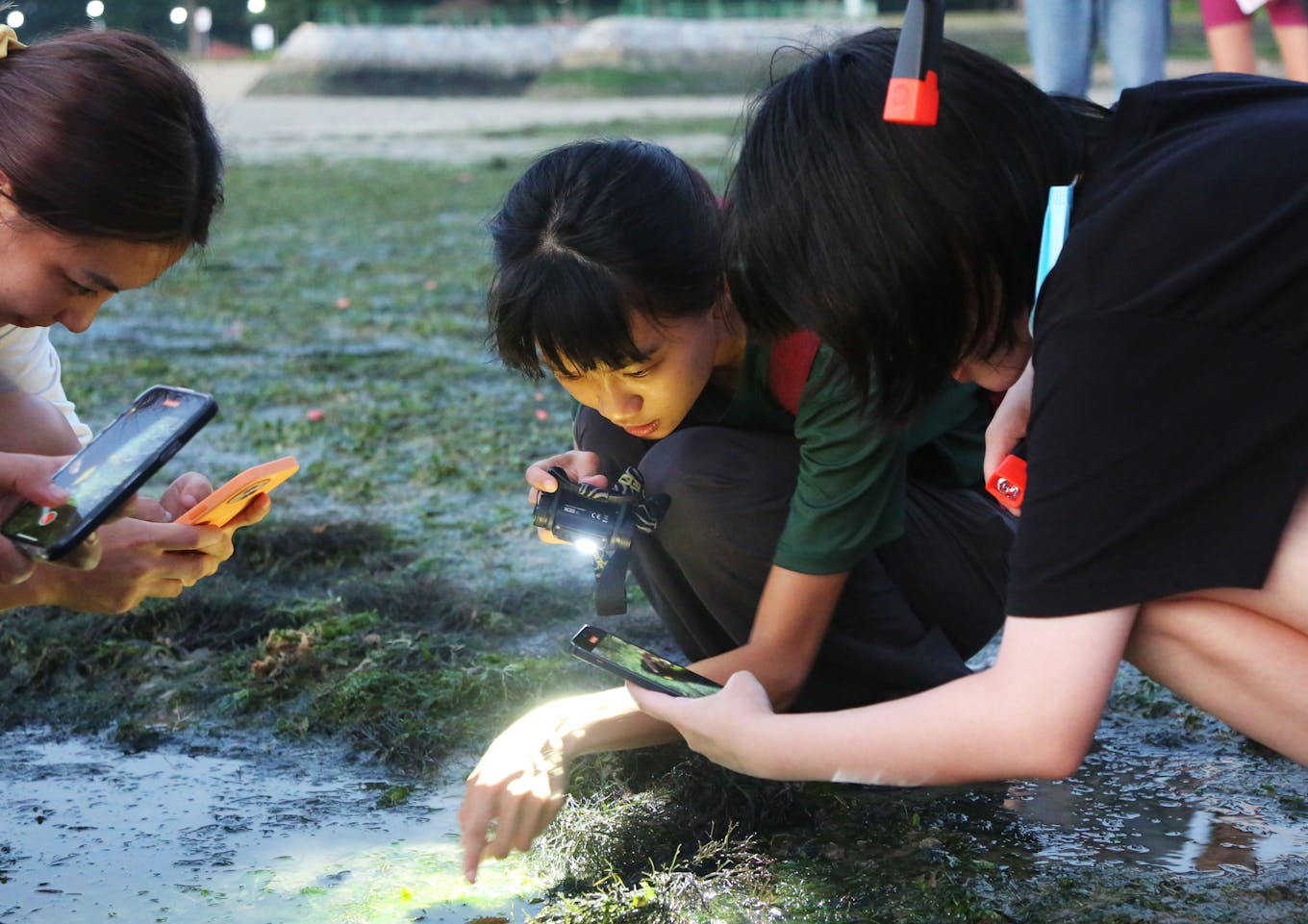
The Untamed Paths runs ecological field trips and outdoor programmes for young children. Image: Neo Xiaoyun
On your social media account (@eyes.uncloudedd), you shared paragraphs from this book titled Braiding Sweetgrass by Robin Wall Kimmerer, and it is about our loss of the Indigeneous way of knowing. Singapore is an immigrant society, and many of us are children of immigrants. Do you think that should impede us when thinking and talking about the land we live on?
The book, in many ways, was transformational for me. I graduated from university in June 2019 and was thrown into the working world. Then I found GUI, was slightly happier but then I couldn’t really find the words to describe the sense of joy that I had. Braiding Sweetgrass came along and I started thinking: GUI is my way of connecting to the land.
In Singapore, I think very few of us can say we are Indigenous. When I encountered the book, [groups that worked on featuring Singapore’s Indigenous islanders like] Orang Laut SG and Wan’s Ubin Journal hadn’t started. Even now that there are these groups that are quite active, not many people can directly relate to them because we are affected by majority culture. We support their work, but there might not be much resonance or relevance to us.
But I think we need to find our own way of relating to the land. For me, it is trying to do different things such as touching the ground, or having a picture of a pangolin on my computer screensaver so that I can talk about it to anyone who sees it. It is one way we can combat eco anxiety too. I have never been one to sit and mull over things, or be thrown into a depressive state, and I think I am lucky. I don’t think we can just say, “I am just another human being here to get resources from the earth.” We need to know we are connected to the land somehow and it’s not a place where we pass through in life. Otherwise I will just be feeling like I’m waiting for life to happen outside of Singapore when there is a lot of life here.
I also think being able to share whatever beauty that remains is a positive thing. A lot of people in Singapore are saying the same thing. We are starting to recognise that so much in Singapore is urbanised, we have cut down 95 per cent of our forests, 95 per cent of our mangroves, and lost 70 per cent of our coral reefs, but there is still so much nature thriving and so much biodiversity adapting and regenerating. As long as we give it space.
You also write about nature. How do your double identities of being a writer and an environmental educator come together for you? Do you worry about romanticising nature too much?
I am ultimately a very pragmatic person, and I hope that my writing does not alienate. It is why I choose to use simple language as much as possible. I don’t want to add to the noise.
Writing the essay Eating Chilli Crab in the Anthropocene, I was trying to get readers to think about what a transition to a low-seafood, low-meat diet looked like. I left it open-ended and it was more about opening up the conversation about our relationship with food. In another recent essay I penned for a collection of writings on indigenous ecologies, I had to hark back to something that was more spiritual for me, because indigenous ecologies as a topic is difficult for me to write about. It might seem a bit fluffy but I think writing is very aspirational. You start writing something and then you align with what you wrote. If I write it, I can slowly move towards it. I hope my writing also helps people connect with each other and help push their own visions for themselves.
The interview has been edited for brevity and clarity.
Neo Xiaoyun was one of 10 young sustainability leaders selected for the Eco-Business Youth A-List 2022. Read our stories with the other winners here.














